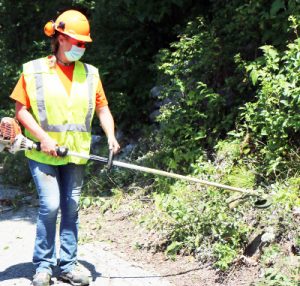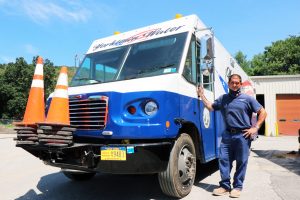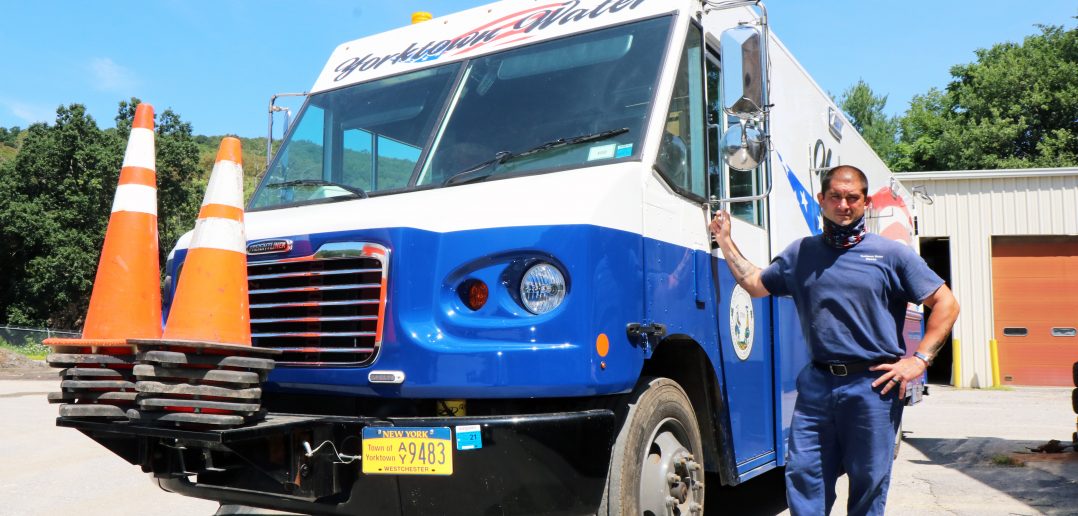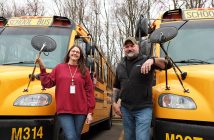
Patty Dickan, a laborer, trims overgrown brush
on the side of a road.
Editor’s Note: When the COVID-19 pandemic hit New York earlier this year, highway workers employed by the state Department of Transportation and local governments were gearing up for their annual busy, warm-weather road maintenance season.
As the pandemic paused much of the state, highway workers had to quickly adjust to new protocols to continue to maintain roadways. Through it all, strong workplace safety and health measures helped keep the workers safe.
Many highway workers have also been playing a key role in responding to the crisis, including transporting supplies, building signs and traffic patterns for outdoor testing sites and taking measures at worksites to allow public employees to provide services more safely.
Here is a look at how DOT and local government highway workers in the hard-hit Long Island and Southern regions are facing what is becoming the new normal.
Strong relationship helped keep Yorktown safe
YORKTOWN HEIGHTS — With CSEA members working outdoors on roads and infrastructure, staying safe on the job has generally focused on work zone safety and confined space training rather than masks and social distancing.
For CSEA members in the Town of Yorktown Unit, that changed when COVID-19 hit Westchester County hard. In his many years as a union leader, Unit President Keith Kuttruf has spent countless hours advocating on his members’ behalf, but the pandemic brought the new challenge of quickly implementing COVID-related safety measures.
The immediate measures taken for workers in the highway and water departments differed somewhat compared to what was done for workers in office settings.

Kuttruf
“It’s been all hands on deck,” said Kuttruf. “I speak with the town supervisor and highway superintendent every week. We instituted one worker per truck, as often as possible.”
To accommodate that, the town brought out trucks normally used for winter work and put them into service. That’s not all. Even outdoors, members have been careful about staying masked or maintaining distance. Lunch breaks are staggered, with many eating outdoors when possible. Hand sanitizer and masks are also readily available.
Kuttruf credits Yorktown’s new town supervisor, Matt Slater, for making workplace safety and health a priority. Slater had just a few months on the job when COVID-19 hit.
“We have a new supervisor who is willing to listen to us,” Kuttruf said. “He’s called regularly to check in and has shown his administration is concerned about the safety and health of the workers. We’ve established a really collaborative relationship, which has made such a difference with morale.”
Part of that collaboration has meant that the unit Safety and Health Committee played a role in evaluating workplace safety measures and making recommendations.

Adam Cerrato, heavy equipment operator for the Town of Yorktown, with the van the Yorktown Water District uses for water infrastructure repairs.
“We walked through every town facility to see how we can make sure we’re keeping people safe,” said Unit 2nd Vice President Adam Cerrato, committee chair and a former fire chief.
In addition to the measures taken for the highway and water crews, Cerrato said collaboration resulted in a number of steps taken for offices and recreation facilities. One worker created Plexiglas partitions that are suspended from office ceilings. The town repurposed old library book drops to allow residents to drop off items in a safer manner. Workers even cut out space for a window at the water department headquarters, which will keep office staff safer when residents drop by.
Outside the office setting, workers helped residents have some normalcy this summer by opening one of the town pools. In addition to limited occupancy and constant cleaning, workers painted boxes at the pool to ensure families are properly distanced.
“Our staff has gone above and beyond to implement every safety feature possible,” said Slater. “The safety and wellbeing of our employees has been our top priority. Working together, we’ve been able to keep government functioning,” while keeping workers safe.
— Jessica Ladlee



